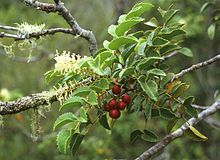Gevuina
| Gevuina | |
|---|---|

| |
| Chilean hazel with flowers and fruits | |
| Scientific classification | |
| Kingdom: | Plantae |
| Clade: | Tracheophytes |
| Clade: | Angiosperms |
| Clade: | Eudicots |
| Order: | Proteales |
| Family: | Proteaceae |
| Subfamily: | Grevilleoideae |
| Tribe: | Macadamieae
|
| Subtribe: | Gevuininae
|
| Genus: | Gevuina Molina |
| Species: | G. avellana
|
| Binomial name | |
| Gevuina avellana | |
Gevuina avellana (Chilean hazelnut (avellano chileno in
The name Gevuina comes from guevin, the Mapuche Indigenous name for the Chilean hazel.[3] The origin of the Spanish name, avellano come from the fact the Spanish settlers found the nuts similar to the hazelnuts they knew from Europe.[1] Yet the species are not closely related.[1]
The concentration of Gevuina avellana in forest is highly irregular and difficult to predict.[1] It may grow on flatland or hilly terrain, in clay or stony soils.[1] Usually Gevuina avellana grows in association to other broad-leaved trees such as Nothofagus obliqua, Nothofagus dombeyi, Nothofagus alpina, Nothofagus glauca or Laureliopsis.[1] Yet it does also grow in associations dominated by the conifers Austrocedrus, Fitzroya and Pilgerodendron.[1] As such Gevuina avellana does not form pure stands.[1]
Taxonomy
Gevuina is a
Uses and cultivation
The
The tree is a good honey plant for bees and is also cultivated as an ornamental plant. The seed shells contain tannin that is used for tanning leather. The tree has an acceptable frost resistance (at least −12 °C (10 °F)) when mature. The wood is cream-colored with dark brown streaking and is used in cabinetry and musical instruments. It was
As of 1982, only a tiny fraction of the nuts of wild stands were collected for processing.[1]
Gallery
-
Leaves and flowers
-
Twig
-
Flowers and fruits
-
Fallen nuts
See also
- Avellanita bustillosii
Notes
- ^ In the north Gevuina avellana grows along the coast beyond Itata River[1] as part of the Maulino forest.[2] To the south the plant grows as far as Guaitecas Archipelago.[1]
References
- ^ a b c d e f g h i j k l m n Karmelić V., Julia, ed. (1982-07-01). Recoleccion e industrializacion de avellana chilena (Report) (in Spanish). Intec-Chile.
- ^ Bustamante, Ramiro O.; Simonetti, Javier A.; Grez, Audrey A.; San Martín, José (2005). "Fragmentación y dinámica de regeneración del bosque Maulino: diagnóstico actual y perspectivas futuras" [Fragmentation and regeneration dynamics of the Maulino forest: present status and future prospects] (PDF). In Smith, C.; Armesto, J.; Valdovinos, C. (eds.). Historia, biodiversidad y ecología de los bosques costeros de Chile (in Spanish). pp. 529–539.
- ^ "Gevuina avellana". Enciclopedia de la Flora Chilena. Retrieved 2009-06-27.
- ^ A.C.Smith & J.E.Haas, 1975. American Journal of Botany, 62: 142.
- ^ A.C.Smith, 1985. Flora Vitiensis Nova 3: 754.
- ^ "ABRS Flora of Australia Online Search Results". www.anbg.gov.au. Retrieved 23 June 2018.
- ^ Weston; Barker, Nigel P. (2008). "A new suprageneric classification of the Proteaceae, with an annotated checklist of genera". Telopea. 11 (3): 339.
- ISBN 0-9628087-0-9
- S2CID 81540094.
- ^ FR 2681530 A1 (SO.F.I.A. Cosmetiques (S.A.R.L.)) 26.03.1993
- ^ "Plantas de la flora de Chile cultivadas en España" [Chilean plants cultivated in Spain] (PDF). José Manuel Sánchez de Lorenzo-Cáceres. Archived from the original (PDF) on 2009-03-20. Retrieved 2009-06-27.
- ^ "Gevuina avellana in Washington Park Arboretum" (PDF). Seattle Government. Archived from the original (PDF) on 2009-03-24. Retrieved 2009-06-27.
Sources
- Rodríguez, Roberto; Mathei, Oscar y Quezada, Max. 1983. Flora arbórea de Chile. Universidad de Concepción. 408p.
- Donoso, C. 2005. Árboles nativos de Chile. Guía de reconocimiento. Edición 4. Marisa Cuneo Ediciones, Valdivia, Chile. 136p.
- Hoffmann, A. 1982. Flora silvestre de Chile zona araucana. Edición 4. Ediciones Fundación Claudio Gay, Santiago, Chile. 258p.
- Muñoz, M. 1980. Flora del Parque Nacional Puyehue. Editorial Universitaria, Santiago, Chile. 557p.
- "Gevuina avellana". Enciclopedia de la Flora Chilena. Retrieved 2009-06-27.
- "Gevuina avellana in Scotland". PlantenTuin Esveld. Retrieved 2009-06-27.
- "Gevuina avellana: Potential for commercial nuts". Acta Horticulturae. Retrieved 2009-06-27.
- "A cool climate nut of the Proteaceae plant tropical family" (PDF). New Zealand Crop & Food Research. Archived from the original (PDF) on 2008-10-14. Retrieved 2009-06-27.




